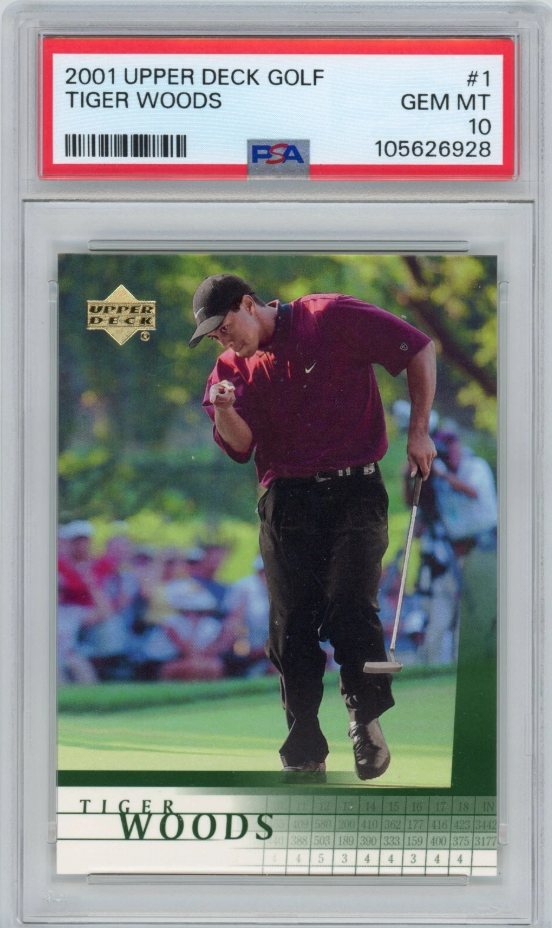In the ever-evolving world of sports memorabilia, few items wield the gravitational pull of Tiger Woods’ 2001 Upper Deck rookie card. It’s not just a piece of cardboard; it’s a time capsule, encapsulating a pivotal moment in both Tiger’s storied career and the landscape of golf. The card’s allure is as simple as it is profound, making it a cherished relic that continues to captivate collectors regardless of their sporting preference.
The charm of this card begins with its design, which speaks volumes with its simplicity. Uncomplicated in layout, it presents Tiger Woods just as he was emerging into the global spotlight, riding the crest of his multitude of victories. The format is clear and recognizable, even to those unfamiliar with the intricacies of golf cards. It’s the definitive version that defines what a Tiger Woods rookie card should be, instantly recognizable to aficionados and casual observers alike.
For many collectors, the card epitomizes the concept of a “blue chip” golf card. It strikes the perfect balance between being findable, thanks to its adequate supply, and being desirable, ensuring that pristine copies don’t gather dust. The market for this card remains active, with prices for PSA 10 graded versions showing modest fluctuations between $200 and $350 over recent months. Such stability in the market is both a boon for established collectors and an accessible entry point for newcomers looking to invest.
This card is akin to a sturdy bridge between past and present. It recalls an era where Tiger Woods’ dominance turned even the most indifferent focus toward golf, while also fitting seamlessly into the range of modern memorabilia where market data and pop reports are just a tap away on your smartphone. So why does this card retain such steadfast popularity? A significant part of its charm resides in its straightforward identity. It’s not an alternate variant or a niche promo; it stands as the flagship entry of a line that reinvigorated interest in golf cards at the dawn of the new millennium.
The card’s sustained demand is equally fueled by its well-documented scarcity and condition dynamics. Many have been graded, ensuring its enduring liquidity, but achieving a pristine PSA 10 grade is a cut above. Subtle imperfections, such as centering deviations or minute handling wear, mean that a gem mint version is still a prized treasure. Card Ladder reports a substantial population across all grades yet a select number of gem examples, highlighting how a well-preserved card garners premium interest when presented with detailed, flattering imagery.
Design-wise, the card has stood the test of time impressively. The photograph is subtle but effective; its composition and border scheme guide the eye effortlessly to the subject of Tiger himself, bypassing clutter and noise. There’s a sophistication to the aesthetic that transcends merely being a piece of sports memorabilia. This universal appeal ensures the card sits comfortably in varied collections, harmonizing alongside other legends from different sports realms, such as Michael Jordan’s inserts or Tom Brady’s rookie chrome cards.
Collector motivations vary, but they all converge on the card’s enduring value. For some, it’s the nostalgia of the set that signaled a rebirth for golf collectibles under a reputable brand. For others, it’s a piece of history linked to a moment when an athlete became a legend. Some value the card as part of a financial strategy, where its liquidity leaves little to chance thanks to a rich comp history. It’s often the sole golf card in many collections because it checks all the boxes — tradition, recognition, and desirability — within a single slab.
When budgeting for acquisition, the process is straightforward. EBay auctions often dictate the pulse of the market, with most competitive bids landing within the $300 to $350 range, particularly for well-centered and visually appealing examples. Those engaging with PSA 9 grades or raw versions should prioritize quality photos to scrutinize every edge and corner. The buyer pool is diverse enough to support a healthy base price, yet the ceiling can soar when the stars align with impeccable imagery and timing.
For thrill-seekers, this card also offers a ripper’s delight. Seen within sports card repacks, the thrill of potentially unveiling a 2001 Upper Deck Tiger Woods rookie card adds another dimension to its allure. These chase cards are seeded with thoughtful randomness in products like the Silver, Gold, and Platinum Galaxy Rip Packs, making each unveiling an adventure.
What makes the Tiger Woods 2001 rookie card eternally appealing is its ability to bridge the nostalgia of Tiger’s awe-inspiring Sunday performances with the pragmatic aspects of collecting today. This fusion of sentiment and strategy creates a stable and inviting market for the card, turning it into not only an item of historical importance but also a cornerstone of modern collections. It’s a card that speaks without words — a clean, iconic rookie, explainable in the simplest terms and revered for its lasting legacy in the realm of sports memorabilia.

